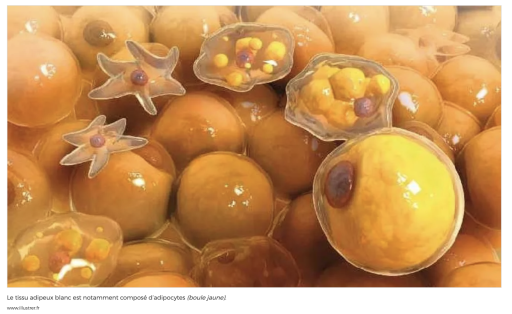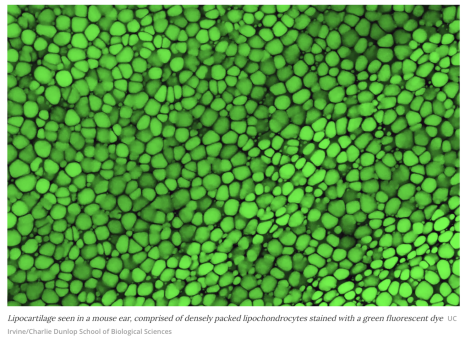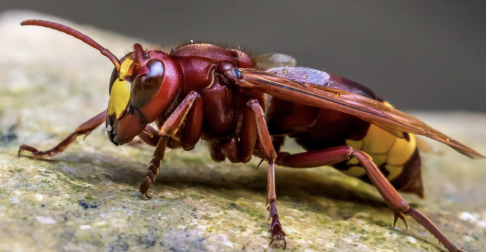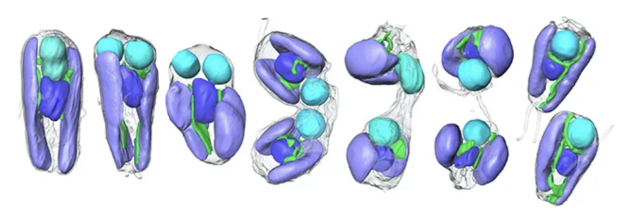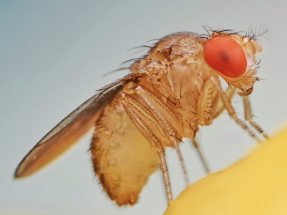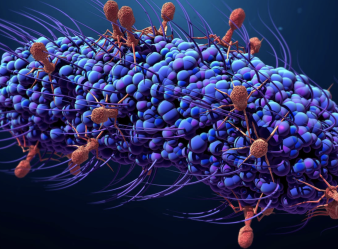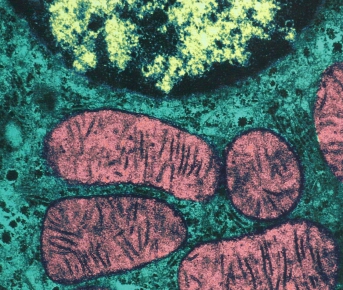
Double vie d'une enzyme du métabolisme des graisses. L'enzyme HSL ou lipase hormono-sensible déjà connue pour son rôle dans la libération des lipides (l'enzyme se fixe sur les goutelettes de lipides présentes dans les cellules adipeuses afin de les dégrader), intervient aussi dans leur stockage. Avant, on pensait donc qu'en son absence, les lipides s'accumuleraient, entraînant une prise de poids. Pourtant, contre toute attente, les souris dépourvues de cette enzyme ne deviennent pas obèses et présentent au contraire une carence en graisse, appelée lipodystrophie. Le même constat a été fait fait chez des individus amish porteurs d'une mutation inactivant la HSL Ainsi, selon l'endroit où elle se trouve dans la cellule, elle exercerait des fonctions distinctes. Une protéine aux deux visages: la HSL se retrouve également dans le noyau des adipocytes (pas de stockage de lipides), intéragit avec des protéines typiquement nucléaires et semble moduler l'expression des gènes (voir en S7). Cette découverte offre de nouvelles pistes pour mieux comprendre la lipodystrophie soit une carence en graisses et l'obésité: trop peu de HSL conduirait à un mauvais stockage des graisses, et trop pourrait favoriser l'obésité. Attention, ceci est encore une hypothèse! Affaire à suivre. 10/25
https://www.science.org/doi/10.1126/science.ads9960
Biologists have made a groundbreaking discovery of a new skeletal tissue known as "lipocartilage" offering immense potential for regenerative medicine and tissue engineering. The lipocartilage found in the ears, nose and throat of mammals is composed of fat-filled cells called lipochondrocytes. The suffix "lipo" refers to lipids meaning fats and the cells storing them, called adipocytes. The term "chondrocytes" refers to the cells producing the cartilage. Lipochondrocytes produce the extracellular matrix, and thus provide super-stable internal support for the cells to develop. This matrix gives to the tissue all the biomechanical properties, namely its flexibility and strength. It makes the lipocartilage an ideal candidate for future treatments of facial defects, birth injuries and cartilage-related conditions like osteoarthritis, rhumatoid arthritis and lupus. Currently, cartilage reconstruction often requires harvesting tissue from the patient's rib, a painful and invasive procedure. In the future, patient-specific lipochondrocytes could be derived from stem cells, purified and used to manufacture living cartilage tailored to individual needs. With the help of 3D printing, these engineered tissues could be shaped to fit precisely. 01/25
https://www.pnas.org/doi/10.1073/pnas.2410874121
Tolerance and efficient metabolization of extremely high ethanol concentrations by a social wasp. Ethanol, a natural by- product of sugar fermentation, can be found in various fruits and nectar. Altough many animals routinely consume ethanol in low concentrations as part of their natural diets, its inherent toxicity can cause severe damage. Even species particularly well adapted to ethanol consumption face detrimental effects when exposed to concentrations above 4%. Here, was investigated the metabolism of ethanol and its impact on survival and behavior in the Oriental hornet (vespa orientalis), a social wasp that naturally consumes ethanol. It was showed that chronic ethanol consumption, even at concentrations as high as 80%, had no impact on hornet mortality, construction behavior, or agonistis behavior. Using carbone 13 labeled ethanol, hornets efficently metabolized ingested ethanol and at a much higher rate that honey bees. The presence of multiple copies of the alcohol dehydrogenase (NADP+) gene in the Vespa suggets a potential mechanism for ethanol tolerance. These findings support the hypothesis that the mutualistic relationship between ethanol- producing organims and vespid hosts may be at the origin of their remarkable capacity to utilize and metabolize ethanol. 10/24
https://www.science.org/doi/10.1126/science.adk1075
The discovery of a special ammonia factory inside a single-celled ocean alga and so, the first known eukaryote to pull nitrogen from air. Until now, the only "nitrogen-fixing" organisms were thought to be prokaryotes such as bacteria. Nitrogen fixation, where atmospheric nitrogen gas is converted into ammonia, is an important process for life. Organisms require access to nitrogen- containing compounds to synthetize essential biochemicals. Bacteria and Archea have this ability. This ammonia factory regarded by a team of scientists as a nitroplast organelle, was once a bacterium that strated living inside the alga about 100 million years ago and has since evolved into a nitrogen- harvesting machine for its host. These bacteria are also known to be symbionts living within this unicellular algae and its relatives. However, the line between symbiont and organelle can be fuzzy. Using X-ray imaging, the team saw that when the algal cells divide; all its organelles arrange themselves in a line and take turns dividing in a well-defined sequence. This "symbiont" participates in that sequence, and it's somehow getting the cue to divide right on time withnthe other organelles. The researchers analyzed the genomes and proteomes made by the algae and the symbiont. About half of the proteins that are physically present inside this symbiont are derived from the host genome. Depending on the scientists, the data show that the two cells have been coevolving for some time, or this symbiont is no longer a symbiont but has evolved into an organelle: the nitroplast. It may also show how mitochondria and chloroplasts evolved into organelles (this process involved symbiont genomes migrating into the nuclear genome of the host, but there does not seem to be evidence of this in thse nitroplast), and so the mechanism by which symbionts are domesticated. To be continued...04/24
Discovery of a phosphate- sensing organelle! A new organelle was discovered in fruit flies! Scientists identified in the guts of these flies tiny reservoirs of phosphate, an element essential to life. These cellular compartments store phosphate in lipid form and release it when there is a shortage. Research continues into whether other animals have this organelle, a phosphate store. 05/23
Un nouvel organite a été découvert chez les mouches à fruits! Les scientifiques ont identifié dans l'intestin de ces mouches de minuscules réservoirs à phosphate, un élément essentiel à la vie. Ces compartiments cellulaires stockent le phosphate sous forme de lipides et en relâchent en cas de pénurie. La recherche continue afin de savoir si d'autres animaux possèdent cet organite, réserve de phosphate. 05/23
Une découverte extraordinaire dans le domaine de la microbiologie! La bactérie Thiomargarita magnifica, espèce extrêmophile, challenge la définition du microbe avec une taille pouvant atteindre 2 centimètres. En effet, ce microorganisme, environ 5000 fois plus gros que la plupart des bactéries, est visible à l'oeil nu! Par rapport à la plupart des bactéries, c'est comme si un être humain rencontrait un autre être humain aussi grand que le mont Everest!
Une autre grande découverte concernant cette bactérie est la présence de deux sacs membranaires tels des compartiments: un séparant son ADN du cytoplasme et un autre permettant la circulation de molécules entre l'intérieur et l'extérieur de la cellule. Ces "compartiments membranaires" représentent un nouveau type d'organite bactérien. Cette bactérie brouille donc la frontière entre procaryote et eucaryote.
Enfin, son génome est très grand soit 11 millions de bases et 11 000 gènes contre 4 millions de bases et 3900 gènes en moyenne pour une bactérie typique. Affaire à suivre... Fev/22
Découverte de plus de 140 000 types de virus qui vivent dans nos intestins, dont la plupart sont inconnus. Après avoir analysé plus de 28 000 métagénomes individuels, provenant de personnes en bonne santé, une équipe internationale a constitué le "Gut Phage Database": un nouveau catalogue géant qui rend compte de la grande variété de virus.
Ces 142 809 types de virus qui vivent dans les intestins humains sont des bactériophages, qui mangent les bactéries et qui font partie de notre écosystème intestinal. Fev/21
https://www.cell.com/cell/fulltext/S0092-8674(21)00072-6?_returnURL=https://linkinghub.elsevier.com/retrieve/pii/S0092867421000726%3Fshowall%3Dtrue
Mitochondria, an organelle devoted to producing energy (ATP) thanks to the exothermic combustion reaction of carbohydrates called "cellular respiration". Glucose is the basic fuel of life and a key ingredient of cells. It oxidizes by this Redox reaction:
C6H12O6 + 6O2 giving 6CO2 + 6H2O
The half reactions are:
O2 + 4H+ + 4e- giving 2H2O
6CO2 + 24H+ + 24e- giving C6H12O6 + 6H2O
The endosymbiotic theory gives an explanation about how eukaryote cells could have evolved from prokaryotic cells that live in symbiosis over 2 billion years ago. Some of these prokaryotes were bacteria that had the ability to use oxygen to produce ATP energy. Some prokaryotes were larger and could consume others. The endosymbiotic theory explains that some of these large cells engulfed some of these small bacteria, but instead of getting digested these small bacteria remained intact and started to live as symbionts (mutualism: a symbiosis where both organisms benefit). This is believed to be the ancestor heterotroph eukaryote cell. Same process for chloroplasts and so, the ancestor autotroph eukaryote cell.
This theory of endosymbiosis is supported by the fact that mitochondria have their own DNA and can duplicate themselves like bacteria. Mitochondrial DNA sequencing is similar to bacteria DNA, but not to eukaryote DNA. The size of mitchondria and chloroplasts tends to be similar to the size of bacteria.
Les mitochondries, un système spécialisé pour produire de l'énergie. Les biologistes s'accordent pour dire que les mitochondries proviennent de l'endosymbiose d'une protéobactérie, ceci il y a environ 2 milliards d'années. Ces bactéries, capables de transformer l'énergie contenue dans certaines molécules en une énergie utilisable pour d'autres réactions chimiques, auraient été ingérées par des cellules anaérobies (vivant dans un milieu dépourvu de dioxygène) avec noyau. Certaines de ces bactéries absorbées sont ainsi devenues des machines à produire de l'énergie très utile au fonctionnement des cellules soit des mitochondries "les centres respiratoires et énergétiques de la cellule". Cette hypothèse de l'endosymbiose est confortée par le fait que les mitochondries ont leur propre ADN et leurs petits organites "ribosomes", qu'elles contiennent des systèmes génétiques complets, et qu'elles peuvent se dupliquer. Le séquencage de l'ADN des mitochondries montre également une similitude avec celui des bactéries et pas avec celui des eucaryotes.
Anakin Skywalker to Qui-Gon Jinn (The Phantom menace/La Menace fantôme).
- Master, I heard Yoda talking about "midi-chlorians". I asked myself, what are midi-chlorians?
- Midi-chlorians are microscopic organisms found in all living cells.
- Are they inside me?
- In your cells, yes. And we live in symbiosis with them.
- What is symbiosis?
- The mutually beneficial association of two living organisms.
- Monsieur-maître, j'ai entendu Yoda parler de "midi- chloriens". Je me suis demandé, c'est quoi des midi- chloriens?
- les midi- chloriens sont des organismes microscopiques qu'on rencontre dans toute cellule vivante.
- Ils sont à l'intérieur de moi?
- Dans tes cellules, oui. Et nous vivons en symbiose avec eux.
- C'est quoi la symbiose?
- L'association réciproquement profitable de deux organismes vivants.
Midi-chlorians do not exist, and were invented by George Lucas for the movie. Nevertheless, Qui-Gon's definition of symbiosis is accurate. The midi-chlorians are
regarded as super mighty mitochondria, the powerful making machine of Jedi's energy.
May the mitochondria be with you!
Les midi- chloriens n'existent pas, et ont été inventés par George Lucas pour le film. Néanmoins, la définition de Qui-Gon sur la symbiose est exacte. Les
midi-chloriens seraient les mitochondries soit les centrales à énergie des Jedi.
Que les mitochondries soient avec toi!
